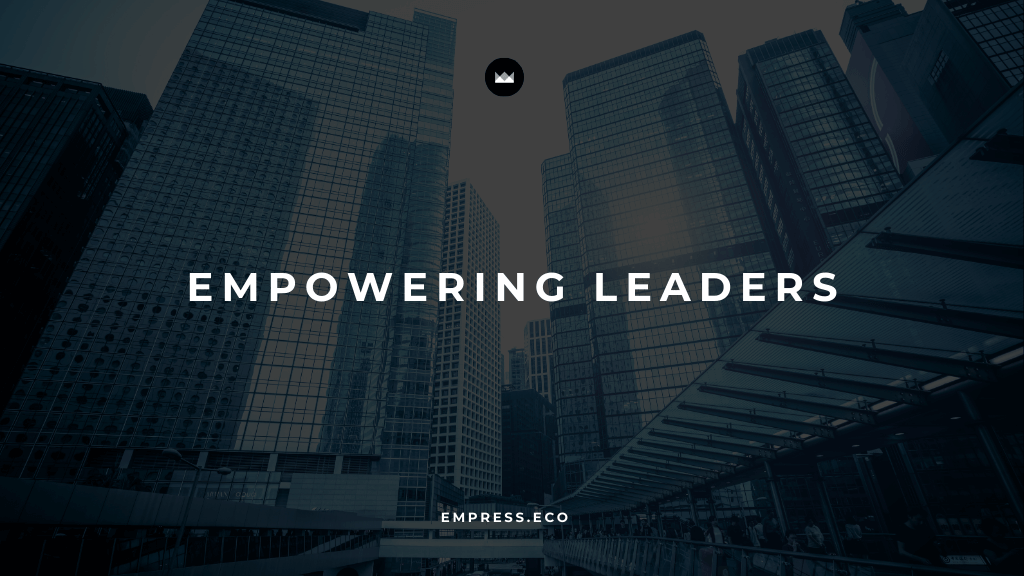
Empowering Leaders to Drive Business Growth in Uncertain Markets
Empower your leadership to turn uncertainty into growth with strategic adaptability.
Table of Contents
When uncertainty strikes in the business world, the first instinct for many leaders is to tighten the reins, reduce risk, and weather the storm. But at EMPRESS, we see things differently. We believe that uncertainty is more than a hurdle to overcome—it’s a catalyst for growth, innovation, and opportunity. In fact, it’s often during the most volatile times that the most impactful leaders emerge, armed with strategies that not only navigate change but harness it to drive their businesses forward.
Today, we’re diving into how your leadership can transform uncertainty into sustainable growth for your business. This is not about quick fixes or surface-level advice. We’re talking about deep, strategic shifts that empower you and your organization to thrive in any market condition. So, let’s get into it—step by step.
Why Uncertainty Can Be Your Best Friend
Before we jump into the nitty-gritty, let’s address something critical: Uncertainty isn’t going away. The world we operate in is increasingly unpredictable, whether it’s due to rapid technological advancements, shifting economic conditions, or unexpected global events. If you’re waiting for the “right” time to act or grow, you might be waiting forever.
But here’s the silver lining: with uncertainty comes opportunity. Think about the companies that have not only survived but thrived during periods of chaos—Netflix during the decline of physical media, Airbnb in the face of hotel industry dominance, and countless others. They didn’t just adapt; they saw uncertainty as a chance to rewrite the rules, reshape their strategies, and create something new.
For you, this means shifting your mindset. Uncertainty isn't your enemy; it’s your playground for innovation and growth.
1. Embrace Adaptability as Your Leadership Superpower
Leadership Isn’t About Having All the Answers
One of the biggest myths about leadership is that great leaders have all the answers. The truth? It’s not about knowing everything—it’s about being adaptable. In an unpredictable market, adaptability becomes your most valuable skill. Adaptability doesn’t mean throwing out long-term goals every time something shifts. It means having the flexibility to adjust your approach without losing sight of your vision.
Let’s paint a picture:
You’re leading a mid-sized retail company, and suddenly there’s a major supply chain disruption. You could stick to the plan and wait for things to normalize. Or, you could adjust on the fly—looking for new suppliers, optimizing your inventory strategy, or doubling down on e-commerce channels. The adaptable leader is the one who sees the disruption as a prompt to innovate, not just react.
Adaptability is proactive, not reactive. It means empowering your team to pivot quickly, explore new options, and make decisions in real-time based on the current market landscape. Leaders who embrace adaptability aren’t thrown off by change—they expect it, plan for it, and use it to their advantage.
How to Build Adaptability:
- Encourage flexible thinking: When new challenges arise, involve your team in solution-building. Encourage them to think beyond traditional approaches and experiment with new ideas.
- Rethink your metrics: Instead of rigid KPIs that force you into a fixed strategy, focus on dynamic metrics that can shift as needed. For example, customer satisfaction may take priority over growth at certain times, allowing you to pivot focus without feeling like you’re losing ground.
2. Leverage Data as a Growth Engine, Not Just a Safety Net
Move Beyond Gut Decisions
Let’s talk about data—because in times of uncertainty, relying solely on instinct can be dangerous. We often hear leaders say, “I know my market, and I know my customers.” While that may have worked in the past, the pace of change today requires a new approach: data-driven leadership.
Data isn’t just a tool to assess past performance; it’s your secret weapon to predict the future and inform decisions that keep you ahead of the curve. The difference between leaders who thrive in uncertain markets and those who merely survive often comes down to their ability to harness data effectively.
Consider this example:
Imagine you run a healthcare company. The industry is evolving fast, with new regulations, patient expectations, and technologies emerging constantly. Rather than guessing how to navigate these changes, you’re able to analyze real-time data on patient behavior, regulatory shifts, and technological trends to make informed decisions. You can predict demand for services, anticipate regulatory changes, and adapt to technological advancements faster than your competitors.
Predictive analytics tools like MindsDB and Metabase help leaders make sense of data and turn it into actionable insights. These platforms allow you to visualize data trends and make predictions about everything from customer behavior to market demands, giving you the upper hand in navigating uncertainty.
Practical Steps to Implement Data-Driven Leadership:
- Invest in predictive analytics: This isn’t about collecting data for the sake of it. Use tools that allow you to forecast trends and make proactive decisions.
- Don’t just track; interpret: It’s easy to fall into the trap of collecting data but not using it. Make sure you and your team are trained to interpret the data and apply it to real-world scenarios.
3. Foster a Culture of Continuous Learning
Your Team’s Ability to Learn is Your Biggest Asset
One thing is certain about uncertainty: things will continue to change. In this context, the companies that thrive are those that never stop learning. A culture of continuous learning isn’t just about upskilling your team—it’s about fostering an environment where learning and innovation are constant.
At EMPRESS, we believe in the power of learning to drive long-term success. Through our SAGE platform, we work with businesses to create tailored learning paths for their teams, ensuring that they’re not just keeping up with industry trends but leading them.
Real-life Scenario:
Let’s say you lead a team at a tech company. You’re constantly faced with new software, frameworks, and methodologies. The businesses that succeed in this kind of environment are those whose teams are constantly learning, growing, and adapting. A team that embraces continuous learning is more agile, more innovative, and ultimately more equipped to handle any disruption that comes its way.
Actionable Tips for Building a Learning Culture:
- Encourage experimentation: Give your team the freedom to try new things, fail fast, and learn from the experience. This fosters innovation and helps your business stay ahead of the curve.
- Invest in learning programs: Consider formal learning and development programs, like the ones offered by SAGE, to keep your team sharp and ready for anything.
4. Embrace Digital Transformation
Technology as a Growth Lever
If you’ve been waiting for the right time to go digital, the wait is over. Digital transformation is no longer optional. In today’s unpredictable markets, it’s the key to staying competitive and driving growth. Digital tools give you the ability to automate processes, analyze large datasets, and connect with customers in new ways—allowing you to scale without compromising on efficiency.
But here’s the good news: you don’t have to do it all at once. The companies that succeed in digital transformation are those that start with small, impactful changes and build from there.
For example:
Let’s say you’re managing a logistics company. Fuel costs are rising, and customer demand is fluctuating. Rather than managing this manually, you can implement AI-powered route optimization software to reduce costs and improve efficiency. Your competitors may still be working with outdated methods, but you’re able to offer faster delivery times at lower costs, thanks to automation.
At EMPRESS, our MAIA division specializes in AI-driven automation solutions that help businesses streamline operations, cut costs, and scale quickly.
How to Begin Digital Transformation:
- Start with high-impact areas: Identify processes that are time-consuming or prone to errors. This could be anything from customer service to supply chain management.
- Implement automation gradually: There’s no need to overhaul your entire business overnight. Focus on one area, see the results, and then expand your digital strategy as you see fit.
5. Build Strong Relationships with Stakeholders
Trust Is Your Best Currency in Uncertain Times
In unpredictable markets, relationships matter more than ever. Whether it’s your employees, suppliers, or customers, strong relationships based on trust and transparency will help you weather any storm. When people trust you, they’re more willing to collaborate, compromise, and stick with you through tough times.
Take the businesses that managed to survive the supply chain disruptions of the COVID-19 pandemic. The ones with strong supplier relationships were able to work together to find solutions, whether it was adjusting delivery schedules or exploring new logistics options. Those relationships, built over time and nurtured through transparency and collaboration, became the lifeline for these companies.
Tips for Building Stronger Relationships:
- Communicate often and openly: Don’t wait for a crisis to reach out. Regularly engage with your key stakeholders and involve them in your decision-making process.
- Collaborate on solutions: When faced with a challenge, work together with your partners and suppliers to find a mutually beneficial solution. Collaboration is a key driver of innovation and resilience.
6. Lead with Purpose
Purpose-Driven Leadership Transcends Market Conditions
Finally, in times of uncertainty, having a strong sense of purpose will guide your leadership. Purpose-driven businesses are not just focused on short-term wins; they’re committed to making a meaningful impact in the world, whether through sustainability, social responsibility, or long-term innovation.
At EMPRESS, we’re passionate about helping businesses integrate Environmental, Social, and Governance (ESG) practices into their strategy through our GAEA division. Purpose-driven companies not only attract loyal customers and employees—they also weather economic storms better because they’re anchored in something larger than themselves.
Real-World Example:
A tech company that incorporates sustainable practices into its core strategy isn’t just cutting costs—it’s building a brand that resonates with environmentally conscious consumers. In the long run, these purpose-driven decisions attract loyalty, create differentiation, and drive growth, even in uncertain times.
How to Lead with Purpose:
- Define your company’s “why”: Why do you exist beyond making a profit? When you have a clear purpose, every decision becomes easier.
- Embed purpose into your strategy: Don’t just treat purpose as a marketing tool. Let it guide your long-term goals and day-to-day decisions.
Conclusion: Time to Turn Uncertainty Into Opportunity
Uncertainty is a constant in today’s world, but that doesn’t mean your business has to stand still. With the right leadership strategies—adaptability, data-driven decisions, continuous learning, digital transformation, strong relationships, and purpose-driven leadership—you can turn uncertainty into your greatest opportunity for growth.
At EMPRESS, we specialize in empowering leaders like you to navigate these challenges and create sustainable, long-term success. If you’re ready to take the next step and harness the power of uncertainty for your business, reach out to us. Let’s build something incredible together.
Ready to Empower Your Leadership? Contact EMPRESS today to start your transformation.
Empress Newsletter
Join the newsletter to receive the latest updates in your inbox.



